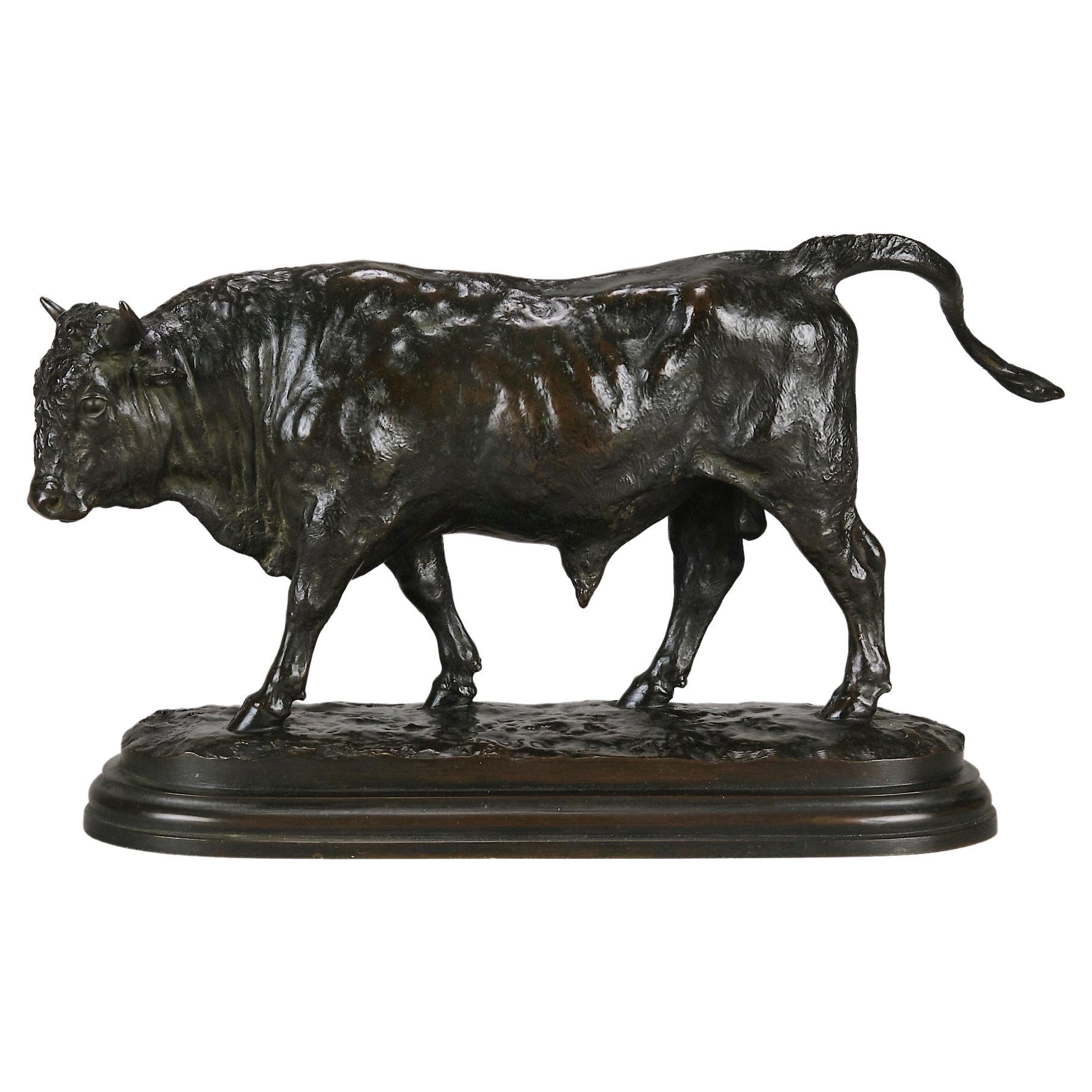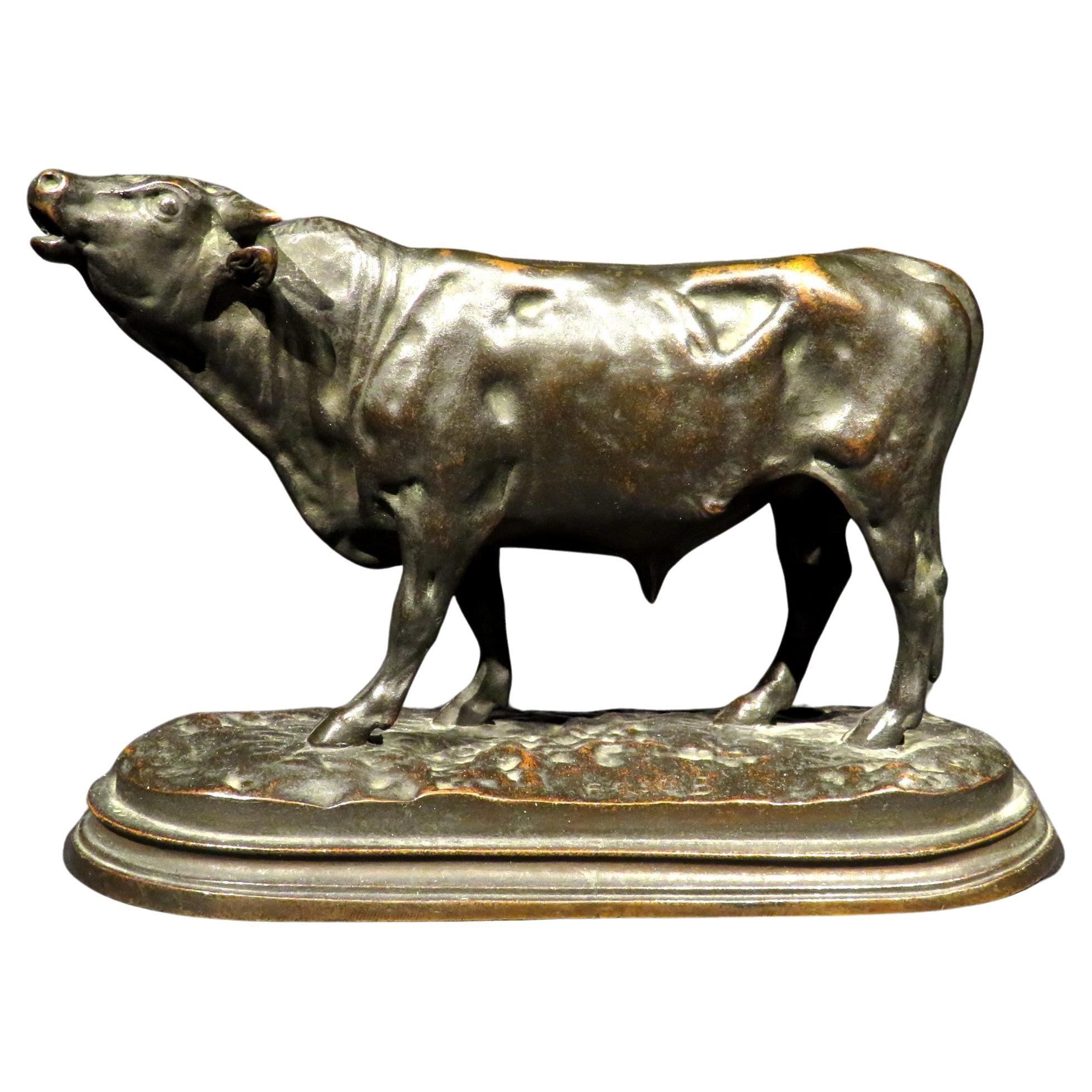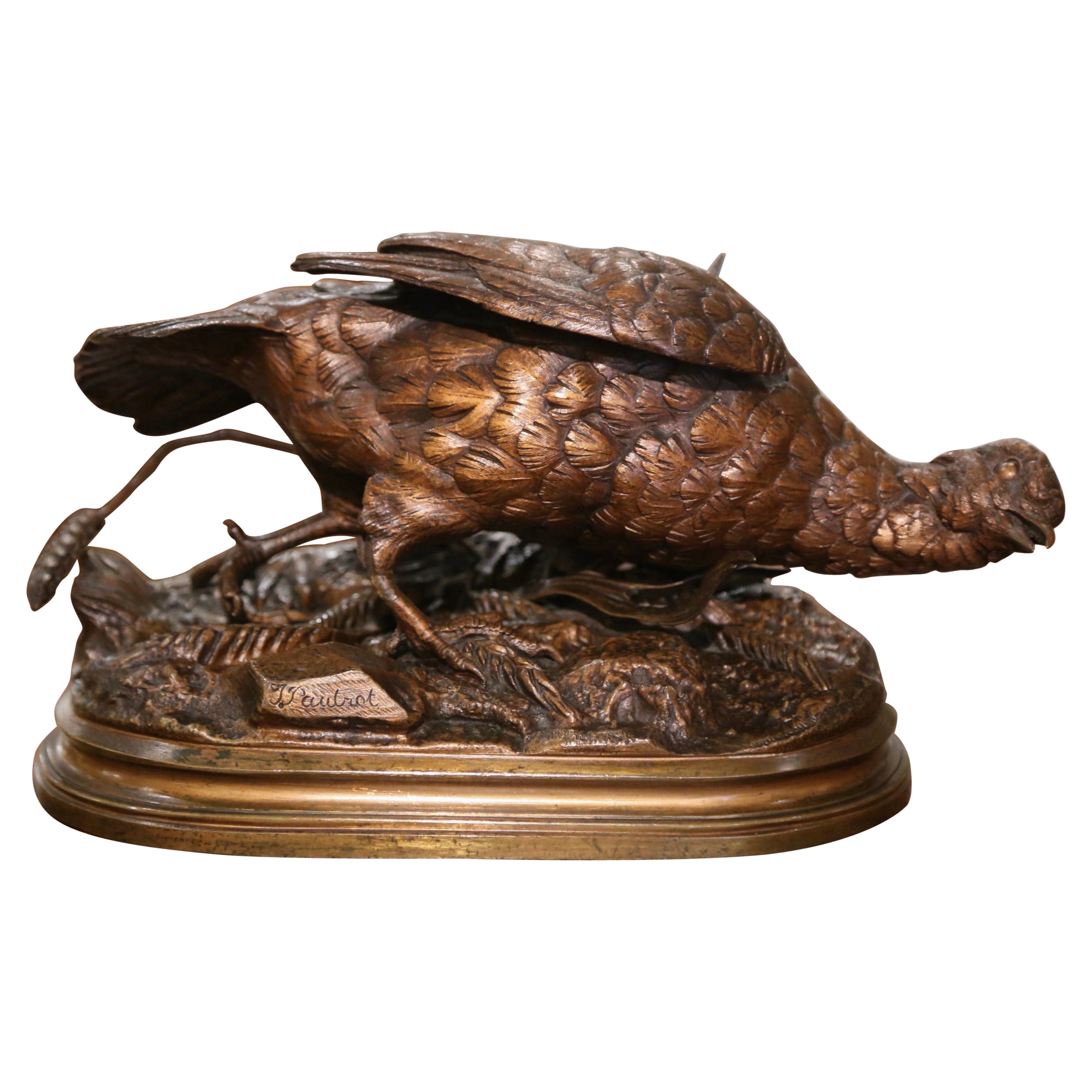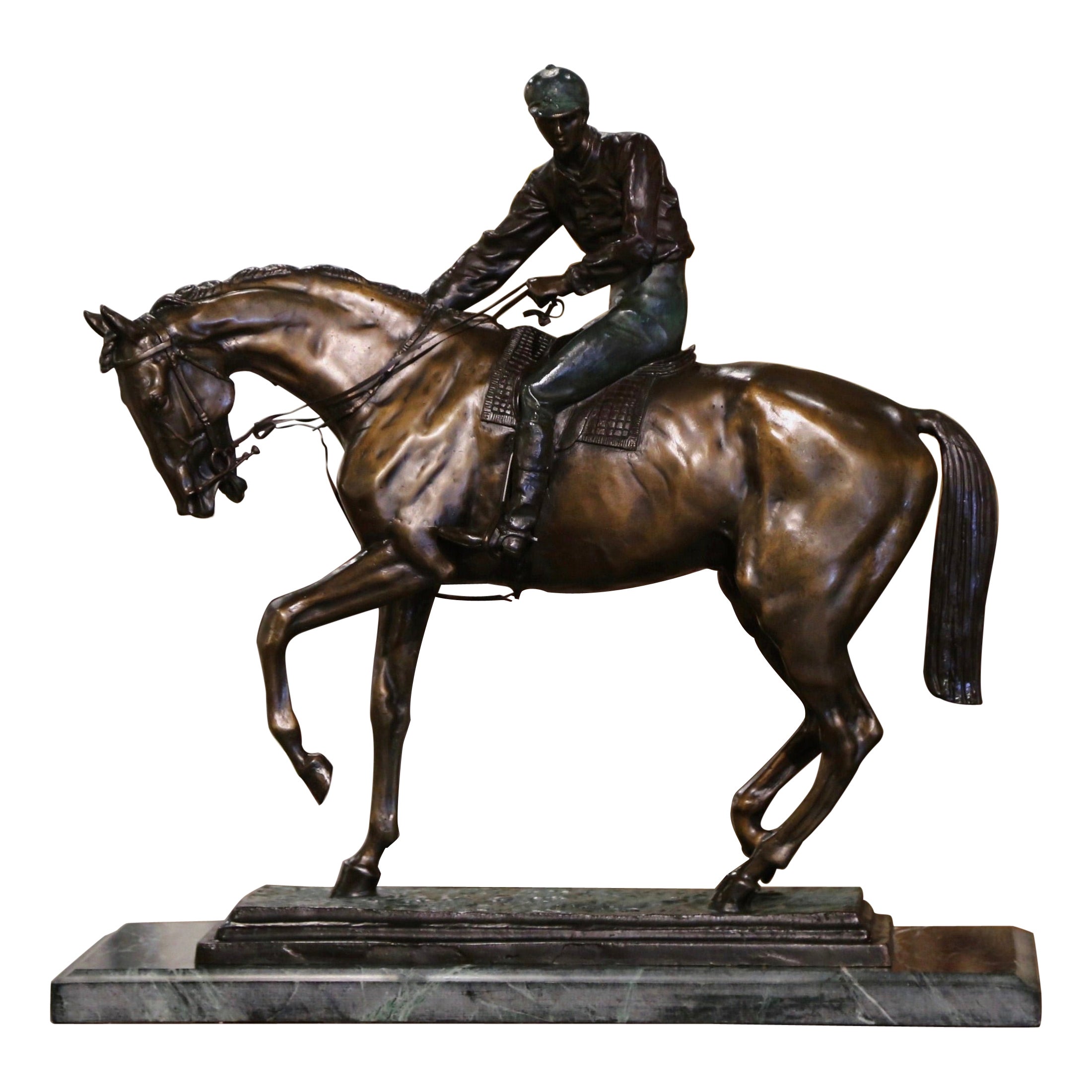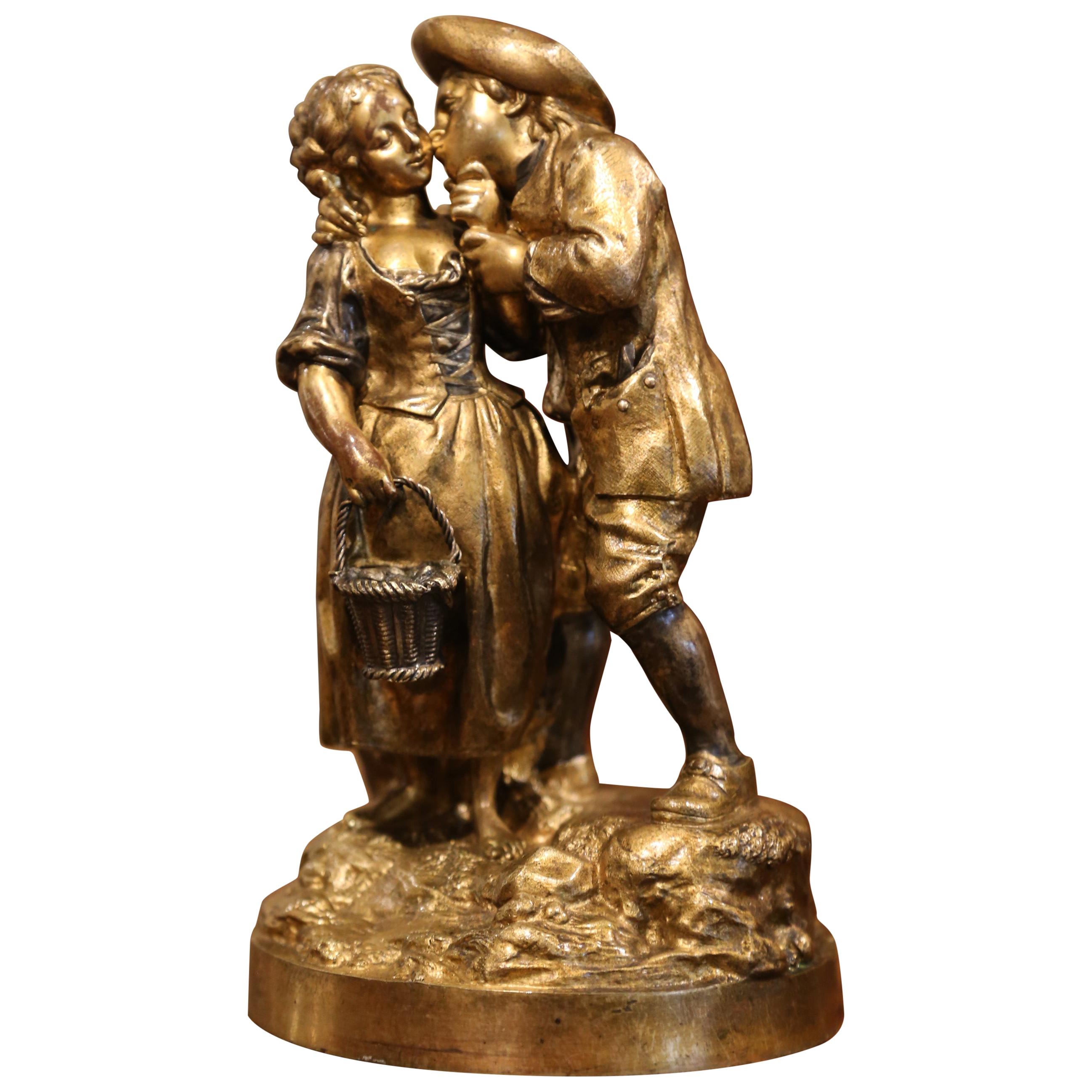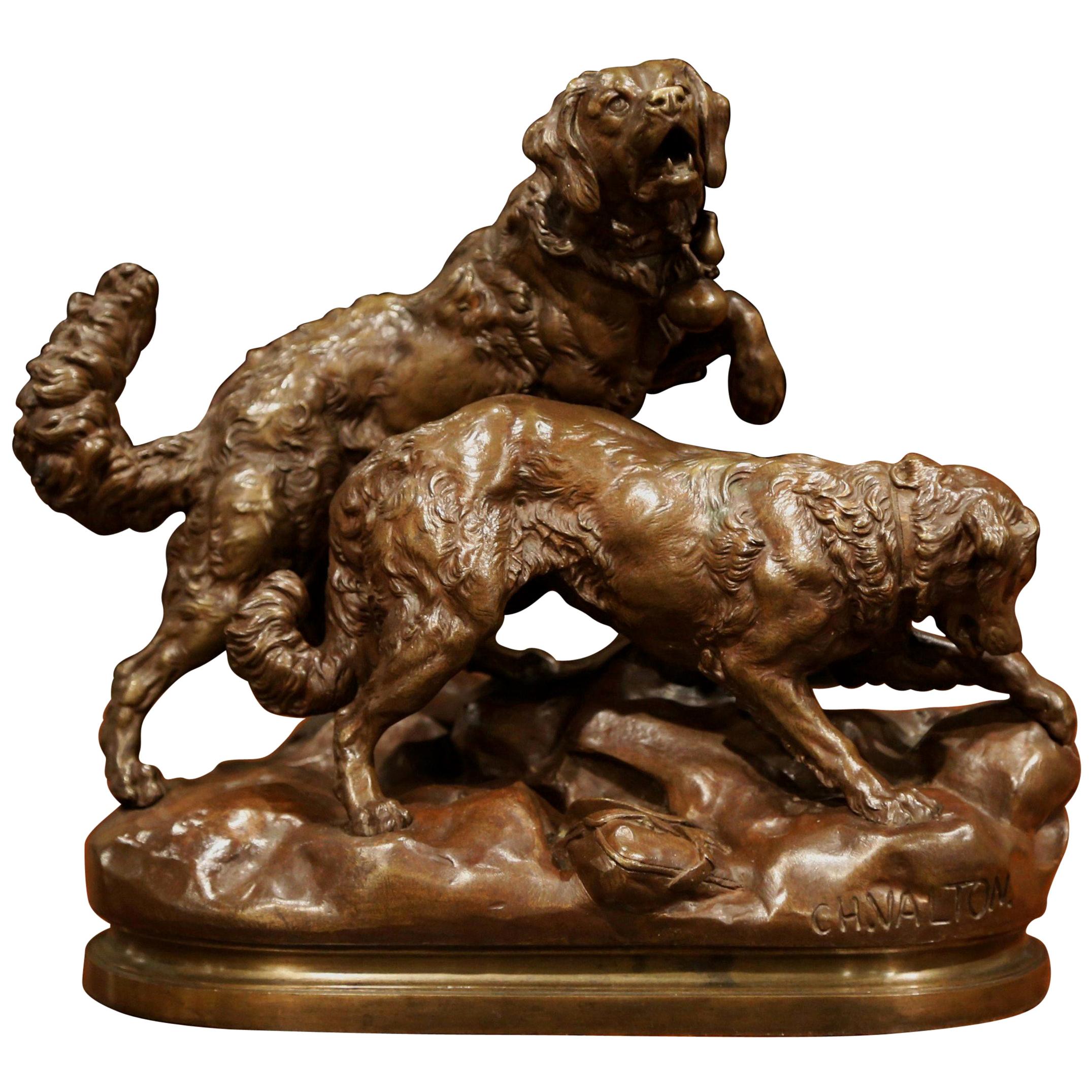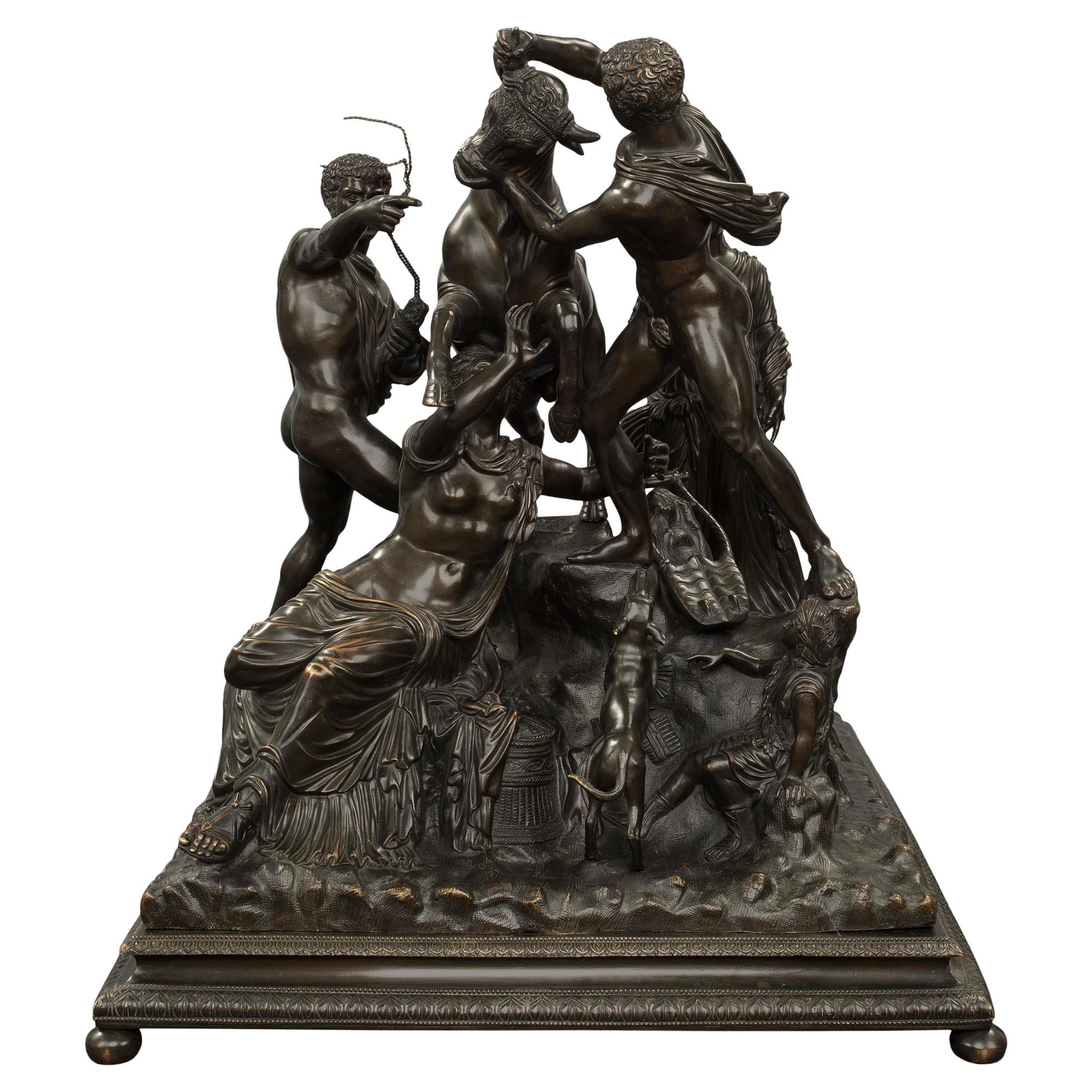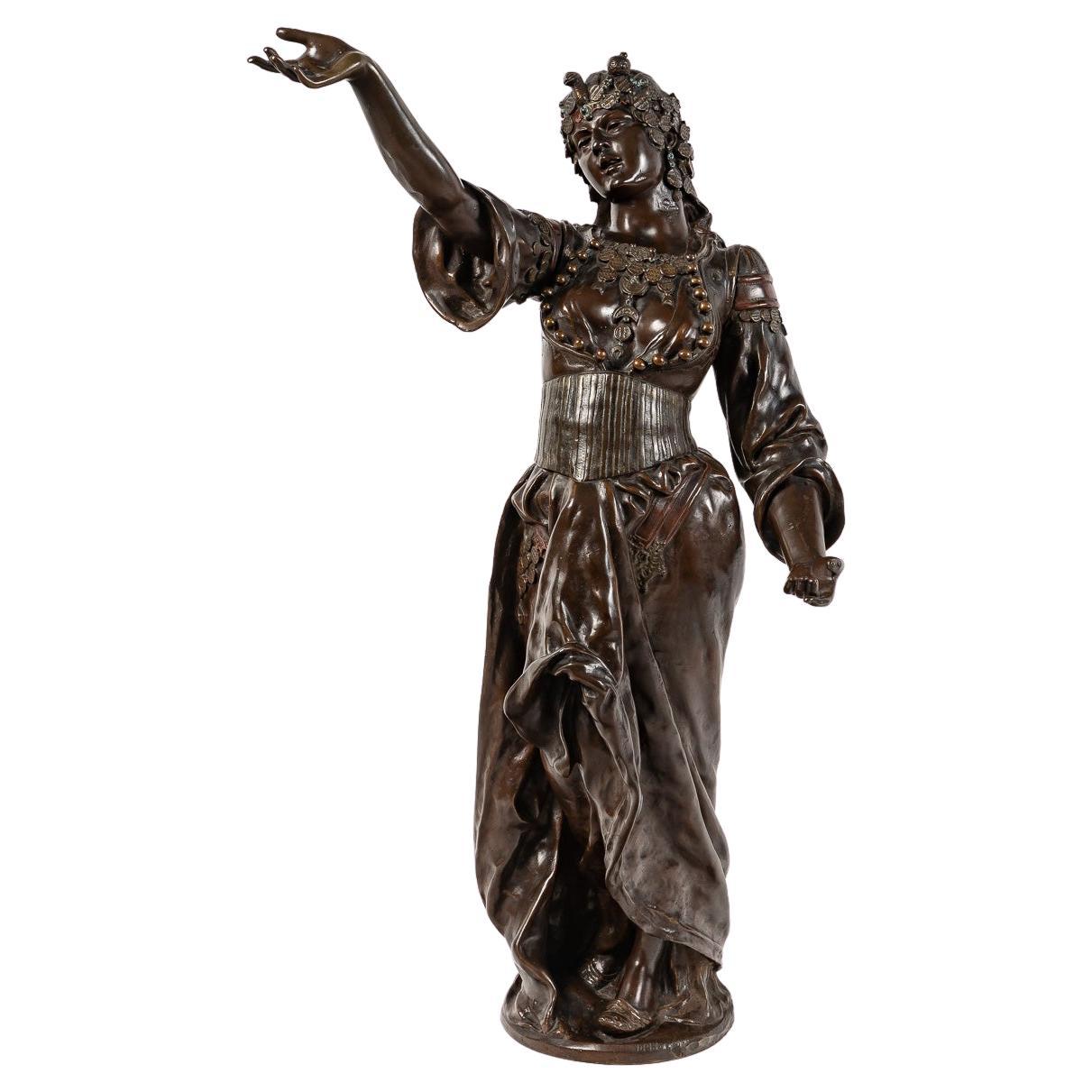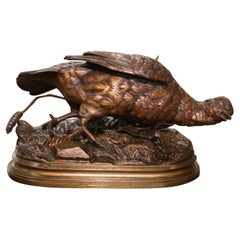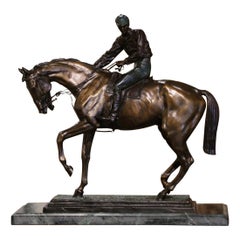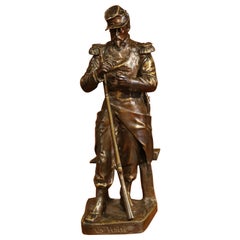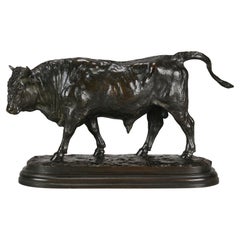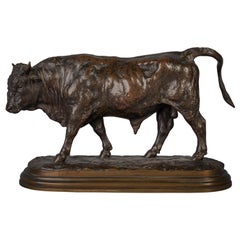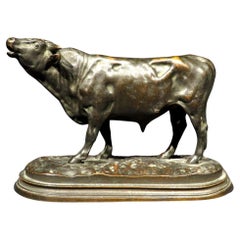
Mid-19th Century French Patinated Bronze Bull Sculpture Signed Rosa Bonheur
View Similar Items
Mid-19th Century French Patinated Bronze Bull Sculpture Signed Rosa Bonheur
About the Item
- Creator:Rosa Bonheur (Artist)
- Dimensions:Height: 15 in (38.1 cm)Width: 14 in (35.56 cm)Depth: 6.25 in (15.88 cm)
- Materials and Techniques:
- Place of Origin:
- Period:
- Date of Manufacture:circa 1860
- Condition:Wear consistent with age and use.
- Seller Location:Dallas, TX
- Reference Number:Seller: 173-1201stDibs: LU95129158341
Rosa Bonheur
Rosa Bonheur was among the most accomplished female painters of the 19th century, a time when women were typically not encouraged to pursue fine arts as a profession. Bonheur never married and lived openly as a lesbian. She is remembered for her realist animal paintings and highly detailed bronze animal sculptures.
Bonheur was born in Bordeaux, France, in 1822. Her mother died when she was just 11. Her father, a painter, believed in female education and supported her artistic pursuits. He oversaw Bonheur’s painting education after her unsuccessful apprenticeship as a seamstress.
Bonheur rose to prominence relatively early in her career. In 1848, the French government commissioned a piece for an exhibition at the Paris Salon. The resulting painting, Ploughing in the Nivernais, is today in the collections of the Musée d’Orsay in Paris. Around this time, she began a relationship with fellow artist Nathalie Micas. The pair remained together for the rest of Micas’s life.
Bonheur’s most famous painting, The Horse Fair, was exhibited at the Paris Salon in 1853 and completed in 1855. It is a depiction of the horse market, where Bonheur went twice a week for a year and a half to work on her sketches. She applied for a police permit to wear men’s clothing for comfort and to dissuade attention. The painting, which measures eight feet across, is in the collections of the Metropolitan Museum of Art in New York.
In 1855, Bonheur’s art dealer introduced her work to the United Kingdom, where her art proved even more popular than in her home country. Her financial success allowed her to move to a large property near Fontainebleau, France, in 1859, where she lived for the rest of her life. It has since been renamed Château de Rosa Bonheur and includes a museum dedicated to her work.
Bonheur was awarded the decoration of the French Legion of Honour in 1865 and was promoted to Officer of the Order in 1894, becoming the first female artist to receive the honor. In 1893, she exhibited at the World’s Columbian Exposition in Chicago.
Bonheur died in 1899 at the age of 77. She was buried in Père Lachaise Cemetery next to Nathalie Micas.
On 1stDibs, find a collection of Rosa Bonheur’s sculptures.
- 19th Century French Patinated Bronze Pheasant Sculpture Signed F. PautrotBy Ferdinand PautrotLocated in Dallas, TXAccessorize a man's office or desk with this elegant antique bronze bird composition. Crafted in France circa 1895, the avian sculpture features a pheasant standing on rocky ground c...Category
Antique Late 19th Century French Animal Sculptures
MaterialsBronze
- Late 19th Century French Bronze Sculpture "Le Grand Jockey" Signed I. BonheurBy Isidore Jules BonheurLocated in Dallas, TXDecorate an office or study with this large antique bronze sculpture. Created in France circa 1880, and signed by French sculptor Isidore Bonheur, the sculpture is set on a green mar...Category
Antique Late 19th Century French Animal Sculptures
MaterialsMarble, Bronze
- 19th Century French Patinated Bronze Sculpture “La Halte” Signed L. MennessierLocated in Dallas, TXThis beautifully detailed bronze figure was sculpted in France, circa 1850. The figural sculpture shows a French soldier in uniform lighting a pipe with his gun by his side, a belt w...Category
Antique Mid-19th Century French Figurative Sculptures
MaterialsBronze
- 19th Century French Patinated Bronze Pheasant Sculpture Signed J.E. MassonBy Jules Edmond Masson 1Located in Dallas, TXAccessorize a man's office or desk with this elegant antique bronze figure. Crafted in France circa 1895, the large sculpture features a pheasant with long tail standing on rocky grounds; the artwork is signed on the base by French artist J. E. Masson. The bird's head is lifted in full attention, with right foot forward in a walking position. The bird figure is in excellent condition, commensurate with age and use, and adorns a beautiful and rich two tone patinated bronze finish. Jules Edmond Masson (1871-1932) was born in Paris in 1871. He was the son of Clovis Masson, who was also a renowned sculptor and a pupil of Barye. J.E. Masson specialized in depictions of animals, as well as equestrian monuments...Category
Antique Late 19th Century French Animal Sculptures
MaterialsBronze
- Mid-19th Century French Patinated Bronze Sculpture Composition "The Kiss"Located in Dallas, TXDecorate a shelf or a woman's writing table with this sweet antique figure composition "Le Baiser"; created in France circa 1860, the bronze sculpture stands on a round base and feat...Category
Antique Mid-19th Century French Louis XVI Figurative Sculptures
MaterialsBronze
- 19th Century French Patinated Bronze Hunt Dogs Sculpture Signed Charles ValtonBy Charles ValtonLocated in Dallas, TXDecorate a man's desk or a library shelf with this antique bronze sculpture composition. Created in France, circa 1890, the sculpture features two hunt dogs standing on a rocky groun...Category
Antique Late 19th Century French Animal Sculptures
MaterialsBronze
- 19th Century Animalier French Bronze Entitled "Taureau Debout" by Rosa BonheurBy Rosa BonheurLocated in London, GB"Taureau Debout" by Rosa Bonheur. An excellent late 19th Century French animalier bronze study of a standing bull with fine hand chased surface that accentuates the muscle definition of the subject, signed Rosa B. ADDITIONAL INFORMATION Measures: Width: 32 cm Height: 18 cm Depth: 11cm Condition: Excellent Original Condition Circa: 1870 Materials: Bronze Book reference: Animals in Bronze by Christopher Payne Page no. 174 DESCRIPTION Bonheur, Rosa (1822-1899) The most popular artist of nineteenth-century France, Rosa Bonheur was also one of the first renowned painters of animals and the first woman awarded the Grand Cross by the French Legion of Honor. A professional artist with a successful career, Bonheur lived in two consecutive committed relationships with women. Born on March 16, 1822 in Bordeaux, Marie Rosalie Bonheur was the oldest of the four children of Raimond Oscar Bonheur (1796-1849) and Sophie Marquis. Bonheur's father was an art teacher who came from a poor family, while her mother, a musician, had descended from a middle-class family and had been her husband's art student. Bonheur's father, who taught drawing and landscape painting, was an ardent member of the utopian Saint Simeon society. The group held idealistic beliefs about the reform of work, property, marriage, and the role of women in society. Most importantly, for the artist's future, the Saint Simeons questioned traditional gender norms and firmly believed in the equality of women. While teaching artistic techniques to his oldest daughter, Raimond Bonheur also encouraged her independence and taught her to consider art as a career. In 1828 Raimond Bonheur joined the Saint Simeons at their retreat outside Paris. Sophie and the children joined him in Paris the following year. Four years later, however, Raimond abandoned his family to live in isolation with his fellow Saint Simeons. Sophie Bonheur died in 1833 at the age of thirty-six. Rosa was only eleven years old when her mother died, but she was aware of the heavy price her mother paid for married life with a man who was more dedicated to his own ideals than to meeting his family's needs. Rosa also saw that her mother's marriage led to poverty and her death from exhaustion. After her mother's death, Bonheur was taken in by the Micas family who resided nearby. Mme Micas and Bonheur's mother had been friends. When Mme Bonheur died, the Micas family paid Raimond Bonheur's debts and cared for Rosa. Their daughther, Nathalie, who would later become an amateur inventor and unschooled veterinarian, and Rosa became enamored with each other. When Rosa Bonheur began her career as a professional artist, she had already been trained by her father who had allowed her to study in all male classes. Rosa also learned by sketching masterworks at the Louvre from the age of fourteen, and later, by studying with Léon Cogniet. From the very beginning, Bonheur's favorite subject was animals. She learned their anatomy completely by dissecting them in local slaughterhouses. She also visited the horse market two times a week. Study of animals by direct observation led to the formation of the realist style in which Bonheur worked. It was for such work that Bonheur obtained written permission from the French government to wear men's slacks. Her working attire also consisted of a loose smock and heavy boots that protected her feet from the dangerous environment in which she painted. The style of dress that the artist adopted for work and home may well have been influenced by her father's attire, which was based on St. Simeonian clothing experiments. Bonheur also cropped her hair, perhaps to facilitate her work. She did, however, always wear dresses for social occasions because she knew that appropriate dress would further her career. Bonheur earned a successful living as a painter of animals. She exhibited at the annual Paris Salon regularly from the age of nineteen in 1841 through 1853, when she was thirty-one. She won the salon's gold medal at the age of twenty-six in 1848 and was commissioned by the French government to paint Plowing on the Nivernais in 1849. In the same year Bonheur and her sister Juliette became directors of l'École gratuite de dessin pour les jeunes filles, a post their father had once held. Bonheur completed her most renowned work, The Horse Fair, in 1855. The successful representation of percherons (a breed native to Normandy) was purchased by Ernest Gambart, a London art dealer whose gallery specialized in work by French artists. He exhibited The Horse Fair in London where Bonheur visited with Nathalie. Queen Victoria requested a private viewing of the painting at Windsor Castle. It would later be purchased in 1887 by Cornelius Vanderbilt and donated to the new Metropolitan Museum of Art in New York City. Bonheur's trip to England allowed her to meet Charles Eastlake, then President of the Royal Academy, John Ruskin, the English writer and critic, and Edwin Landseer, the British animalier. She also toured the English and Scottish countrysides and executed some paintings based on her observations of new breeds of animals found there. Gambart made engravings of Bonheur's work, including The Horse Fair, and sold them in England, Europe, and the United States. Bonheur became one of the most renowned painters of the time. Little girls, such as Anna Klumpke in the United States, even had dolls in her likeness, much as American girls played with Shirley Temple dolls...Category
Antique 19th Century French Art Nouveau Animal Sculptures
MaterialsBronze
- French Bronze Figure of a Bull, by Rosa BonheurLocated in New York, NYInscribed "Rosa B" and stamped with the "Peyrol" foundry on the base.Category
Antique 1860s Animal Sculptures
MaterialsBronze
- A Very Good Beaux Arts Period Animalier Bronze of a Bull, after Rosa BonheurBy Rosa BonheurLocated in Ottawa, OntarioAlthough there is seemingly no apparent foundry mark, this finely cast & patinated animalier bronze known as ‘Bull’ or ‘Taureau Beuglant’ is exemplary in demonstrating exceptional at...Category
Early 20th Century French Beaux Arts Animal Sculptures
MaterialsBronze
- Italian Mid-19th Century Patinated Bronze Statue of the Farnesse BullLocated in West Palm Beach, FLA most handsome and large scale Italian mid 19th century patinated bronze statue of the Farnese Bull. The rich and warmly patinated bronze is raised by a square mottled support with ...Category
Antique 19th Century Italian Figurative Sculptures
MaterialsBronze
- Sculpture in Patinated Bronze, Signed Marcel Debut, 19th CenturyBy Marcel DebutLocated in Saint-Ouen, FR"Sculpture in patinated bronze, signed Marcel Debut, 19th century" Important sculpture in patinated bronze, signed Marcel Debut, XIXth Century, orientalist subject, nice brown pat...Category
Antique 19th Century French Napoleon III Figurative Sculptures
MaterialsBronze
- Late 19th Century Bronze Sculpture of BullBy Isidore Jules BonheurLocated in Dublin 8, IELate 19th Century Bronze Sculpture of a Bull by the French sculptor, Isidore Jules Bonheur. Set on a naturalistic base and raised on a black marble plinth. Signed 'I. Bonheur' and fe...Category
Antique Late 19th Century French Animal Sculptures
MaterialsMarble, Bronze
